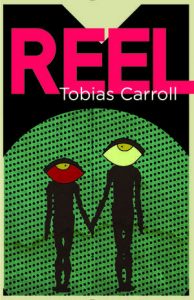Tobias Carroll’s Reel is a fascinating observation on interconnectedness, cause and effect, and the absurdity of the arbitrary values we imbue upon moments of our lives.
This novel shows a penchant for defying prediction. Its plot is cleverly arranged such that there are teasing moments where the reader is encouraged to guess at what might come next, only for those guesses to prove completely wrong. This is not a case of twists for the sake of twists; rather, the sequences of events play out as the lives of two people would, unexpected because real lives are just that. Despite the connective bookends at the beginning and end of the novel, there is a consistent rejection of storytelling conventions that never calls attention to itself and therefore avoids causing the story to stumble. Red herrings are raised again and again (one in particular would make Chekhov roll in his grave), but even calling them “red herrings” is problematic, because they are more akin to the details that two obsessive, meaning-driven people like the protagonists would consistently take note of. We as readers immediately attach meaning and have to confront the fact that any disappointment in the lack of significance for those elements is both our fault and misplaced. In this, Reel serves as a meta-commentary on art and its consumption, beyond the surface layer the protagonists’ employment. The novel highlights the subjectivity of experience and how easily such experiences can be manipulated or even randomly and irrevocably altered.
While nothing happens in the novel that would easily fit under the definition of absurdist, it still leaves such a taste in the mouth, which leaves considerable food for thought. The sequence of the plot plays out in what I can best describe as a romantic comedy in reverse, where the fated meeting of the protagonists occurs early and the story ends with an unexpected, almost deus-worthy connection. The effect of this is powerful in how it asks the reader to look beyond quick impressions and dismissive leaps to presumptive conclusions. In its own way, it subtly shows the consequences of not exploring the truth depth in people and how that lack of curiosity and engagement engenders feelings of isolation and stagnation. At yet, despite that, the characters of the novel are profoundly affected by their interaction, even when that interaction is brief and unpleasant. Imagine how often your mind discards other people from its memory, even those who momentarily frustrate or obstruct you. In a true hallmark of quality storytelling, Reel highlights the potential of imagining people complexly, and without being preachy about it.
One moment of particular note is the catalyst for the story’s action. Early on, Timon, one of the protagonists, attempts to start something like a mosh pit, though his efforts to make it inclusive are highly suspect, and he ends up alone, thrashing and wantonly impacting people for what is probably close to half an hour. The moment is beautifully symbolic for reasons that will become apparent when you read Reel, but for me, by the end of the novel, one idea inspired by that moment stuck out from the rest. There is, I think, a subtle class commentary underpinning much of this novel. We the readers are essentially presented with the effects of boredom and how it drives so much of what those of the middle and upper classes do. Timon in particular, while acutely aware of his depression and dissatisfaction, seems curiously oblivious to his privilege, especially and most immediately with regards to the fact that he has a wealthy family to react against in the first place. This is not to take away from very real fear of being coerced into becoming something he does not want to be, but his one man mosh pits still resonate with the idea that his struggle is as much a form of acting out as it is any real expression. In this, I think Carroll’s work is much more self-aware than other books that have societal disillusionment as a theme, such as Chuck Palahniuk’s Fight Club. Timon might not feel the significance of receiving wads of twenties for lunch with his grandfather, but the reader definitely does.
I think the last word should go to Marianne, the novel’s other protagonist. She is a woman of displacement, or perhaps it is better to say that she is a woman of repeated placement. If Timon represents a locus of indecisiveness, then Marianne is a commitment to action. She and Timon are very similar in many ways, especially concerning their mutual uncertainty and their talent for over-analysis, but Marianne possesses a strength that I think the novel is suggesting would do many people like her some good. She makes decisions for her own reasons, even if she deeply questions those decisions and reasons, rather than allowing herself to be dragged along for the ride and submitting what little control she has. There are, of course, unintended consequences to this, and she is no less guilty of presumptiveness than Timon, but the same could be said of anyone and anyone’s actions.
Overall, Reel is both an easy read and a deeply philosophical book, which is no meager feat. It leaves you wanting to consider other people in more substantial ways, if for no other reason that you understand wanting to be treated as a person with depth.
Reel is available now through Rare Bird Books.




